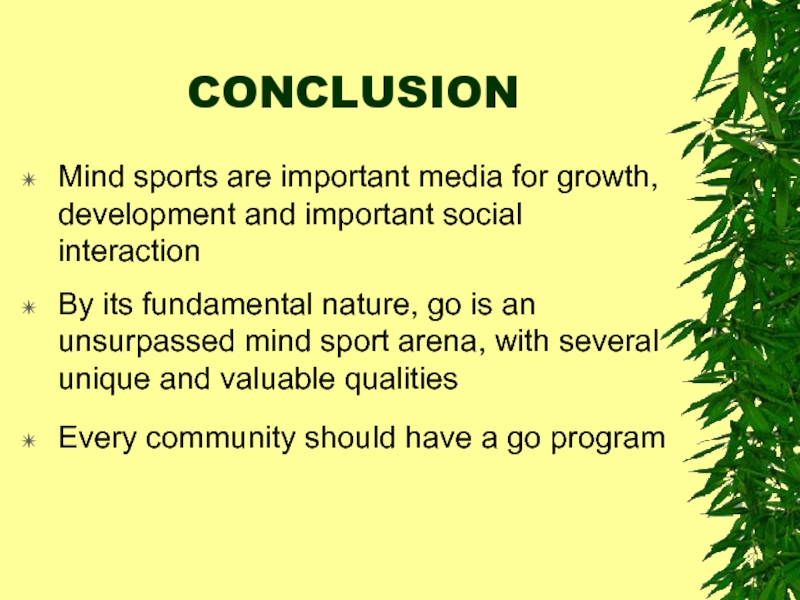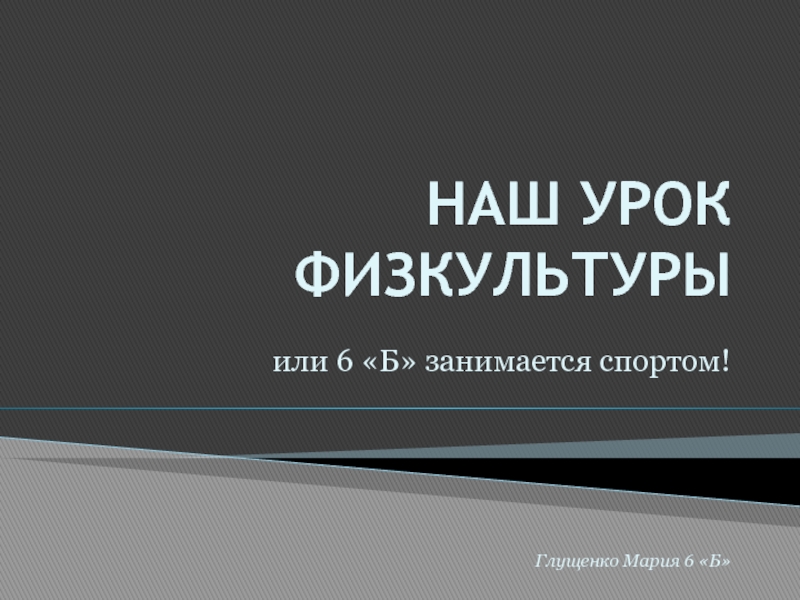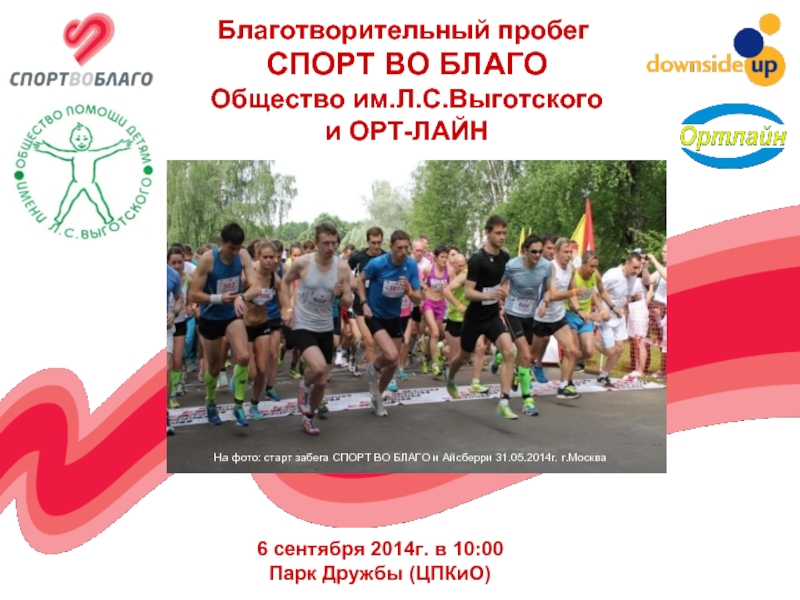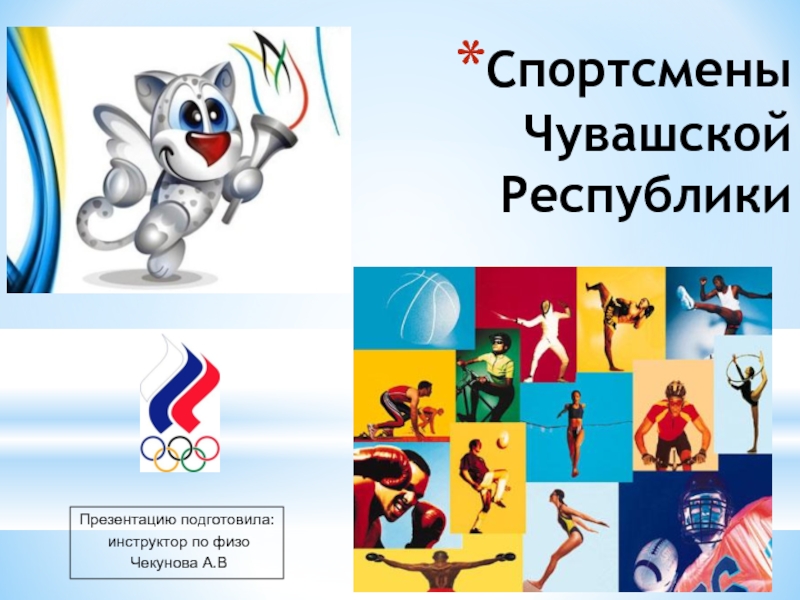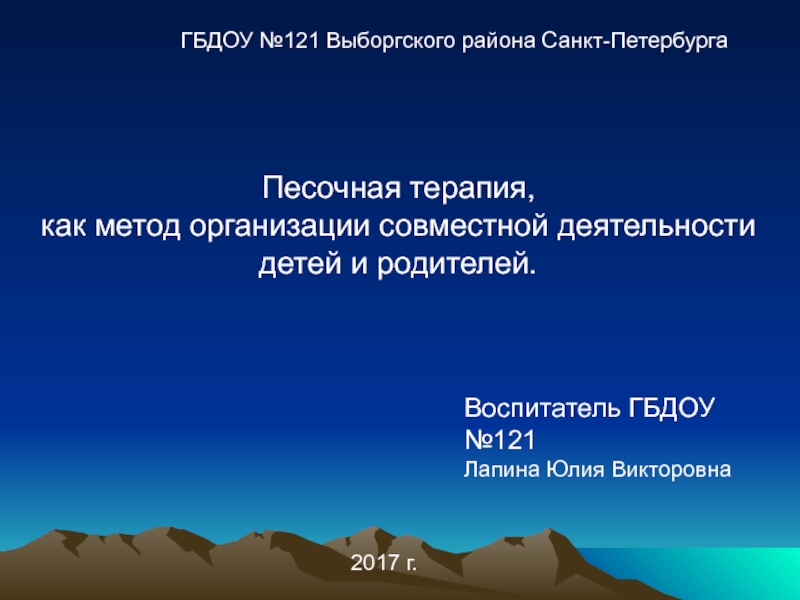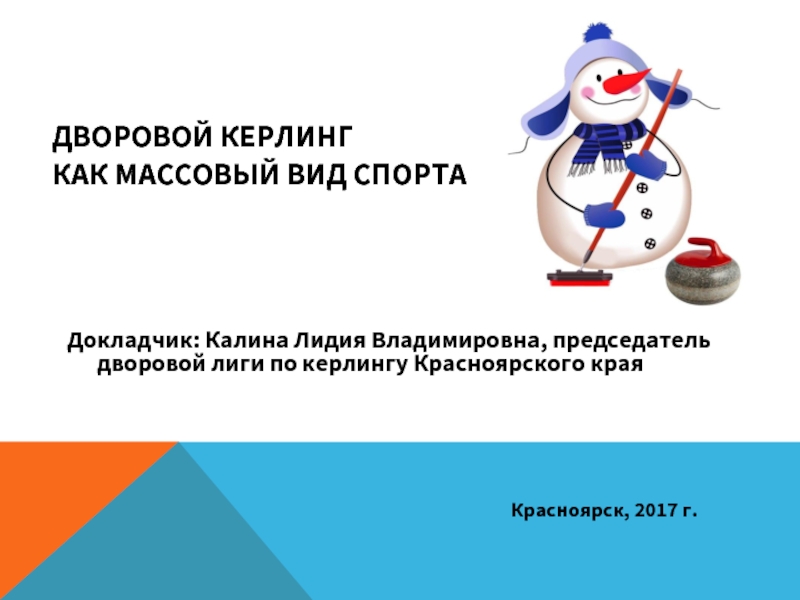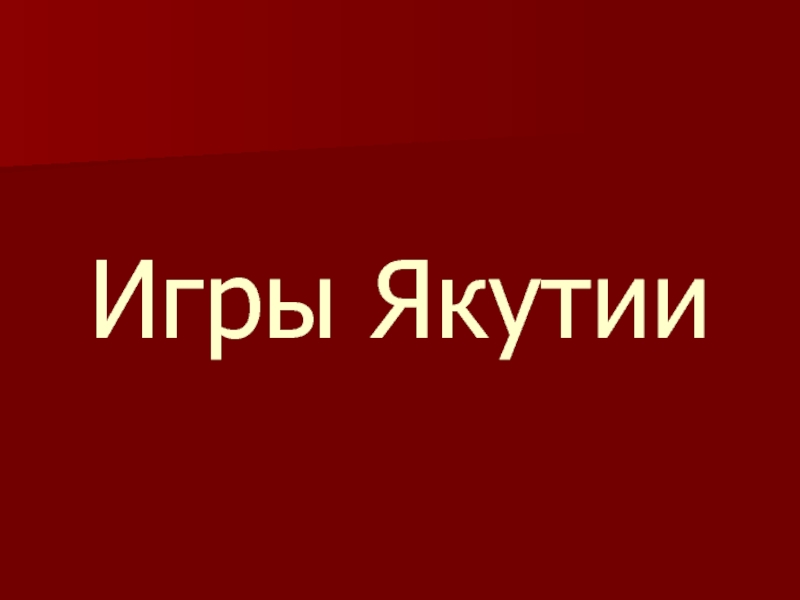should have a go program
- Главная
- Разное
- Дизайн
- Бизнес и предпринимательство
- Аналитика
- Образование
- Развлечения
- Красота и здоровье
- Финансы
- Государство
- Путешествия
- Спорт
- Недвижимость
- Армия
- Графика
- Культурология
- Еда и кулинария
- Лингвистика
- Английский язык
- Астрономия
- Алгебра
- Биология
- География
- Детские презентации
- Информатика
- История
- Литература
- Маркетинг
- Математика
- Медицина
- Менеджмент
- Музыка
- МХК
- Немецкий язык
- ОБЖ
- Обществознание
- Окружающий мир
- Педагогика
- Русский язык
- Технология
- Физика
- Философия
- Химия
- Шаблоны, картинки для презентаций
- Экология
- Экономика
- Юриспруденция
Play go and grow презентация
Содержание
- 1. Play go and grow
- 2. PLAY IS SERIOUS BUSINESS Skill-building Adaptation/maturation
- 3. US MIND SPORT ASSOCIATION . .
- 4. GAME-BASED LEARNING Intrinsic motivation/reinforcement Relevant practice
- 5. THALAMIC ENGAGEMENT Peak experience = Difficult challenge + Sufficient skill
- 6. STRATEGY GAMES TEACH “THE FOUR C’S” Critical thinking Competition Cooperation Communication
- 7. EUROPEAN PARLIAMENT ENDORSES CHESS IN SCHOOLS
- 8. BENEFITS OF CHESS IN EDUCATION Focusing
- 9. CHESS IN THE SCHOOLS INC. New York
- 10. CHESS-IN-SCHOOLS STUDY Students who participate in Chess-In-The-Schools:
- 11. GO VS. CHESS: Five Pluses
- 12. UNIVERSAL RANKING SYSTEM Similar to martial
- 13. CURRICULUM LINKS Social Studies: Historic and
- 14. SCALABLE 9x9 = “Short form” game suitable
- 15. PROGRESSIVE COMPLEXITY >5x times the size of
- 16. GO + CHESS The Benefits Overly tactical
- 17. THREE BIG QUESTIONS What is the
- 18. THREE CLASSIC GAMES BACKGAMMON: Man vs. Fate
- 19. “That we have these three shows that
- 20. A PARADIGM FOR OUR TIME Complex,
- 21. GO-RELATED RESEARCH: THREE RECENT STUDIES
- 22. FOUR AREAS OF IMPROVEMENT FOR YOUNG PLAYERS
- 23. KIM Continued Findings in four areas
- 24. GO USES THE WHOLE BRAIN Xiangchuan Chen
- 25. PLAYING GO CAUSES PHYSICAL CHANGES IN THE
- 26. PHYSICAL CHANGES CONTD. “Long-term baduk training appears
- 27. CONCLUSION Mind sports are important media for
Слайд 2PLAY IS SERIOUS BUSINESS
Skill-building
Adaptation/maturation
Supports other learning
Relevance of other
learning
Important throughout life
Important throughout life
Слайд 3US MIND SPORT ASSOCIATION
. . . is working with the
Berkman Center for Internet and Society at Harvard and the MIT Media Lab to develop an online toolbox that can be integrated into classroom studies to teach go, chess and other games.
Слайд 4GAME-BASED LEARNING
Intrinsic motivation/reinforcement
Relevant practice leads to improvement
Timely feedback
Timely recall
-- http://theknowledgeguru.com/game-based-learning-infographic/
Intrinsic
motivation/reinforcement
Relevant practice leads to improvement
Timely feedback
Timely recall
-- http://theknowledgeguru.com/game-based-learning-infographic/
Relevant practice leads to improvement
Timely feedback
Timely recall
-- http://theknowledgeguru.com/game-based-learning-infographic/
Слайд 7EUROPEAN PARLIAMENT ENDORSES CHESS IN SCHOOLS
Declaration 50/2011 passed with 60%
of the vote on 3/13/12
Calls on the Commission and the Member States to encourage the introduction of the programme ‘Chess in School’ in the educational systems of the Member States
Calls on the Commission, in its forthcoming communication on sport, to pay the necessary attention to the program ‘Chess in School’ and to ensure sufficient funding for it from 2012 onwards
Calls on the Commission and the Member States to encourage the introduction of the programme ‘Chess in School’ in the educational systems of the Member States
Calls on the Commission, in its forthcoming communication on sport, to pay the necessary attention to the program ‘Chess in School’ and to ensure sufficient funding for it from 2012 onwards
Слайд 8BENEFITS OF CHESS IN EDUCATION
Focusing
Visualizing
Thinking Ahead
Weighing Options
Analyzing Concretely
Thinking Abstractly
Planning
Juggling Multiple Priorities
Benefits of Chess in Education Summary, USCF
Thinking Abstractly
Planning
Juggling Multiple Priorities
Benefits of Chess in Education Summary, USCF
Слайд 9CHESS IN THE SCHOOLS INC.
New York City based
$3.3 million budget
Taught 13,000
students in 51 NYC public schools in 2010
Weekly one-hour lessons in grades 3 and 6
After-school programs
Teacher training
Weekly one-hour lessons in grades 3 and 6
After-school programs
Teacher training
Слайд 10CHESS-IN-SCHOOLS STUDY
Students who participate in Chess-In-The-Schools:
Score higher on standardized tests
Use
their chess skills to achieve academic success
Attend school on a more regular basis
Resolve conflicts more peacefully
Create lasting friendship during chess tournaments and after-school clubs
Attend school on a more regular basis
Resolve conflicts more peacefully
Create lasting friendship during chess tournaments and after-school clubs
Слайд 11GO VS. CHESS:
Five Pluses
Natural handicap system
Cultural and historical
links add other levels of interest
Scalable – has short and long forms
Progressive complexity
Speaks to the challenges of modern life in a special way
Scalable – has short and long forms
Progressive complexity
Speaks to the challenges of modern life in a special way
Слайд 12UNIVERSAL RANKING SYSTEM
Similar to martial arts, golf
Inherent in the
game’s structure
All serious players know their rank
Honest players will lose half of their games
The goal is self-improvement, not victory
All serious players know their rank
Honest players will lose half of their games
The goal is self-improvement, not victory
Слайд 13CURRICULUM LINKS
Social Studies: Historic and cultural aspects
Math: Multiplication; using
coordinates; etc.
The Arts: Chinese/Japanese/Korean art
The STE@M curriculum
The Arts: Chinese/Japanese/Korean art
The STE@M curriculum
Слайд 14SCALABLE
9x9 = “Short form” game suitable for classroom instruction
19x19 = “Long
form” for after-school programs
Слайд 15PROGRESSIVE COMPLEXITY
>5x times the size of a chessboard
More possible games than
there are sub-atomic particles in the known universe (10761: Omni, June 1991)
All plays are actually possible
Complexity increases with each play
Each game becomes a record of itself
Always a decisive result – no stalemate, draw etc.
All plays are actually possible
Complexity increases with each play
Each game becomes a record of itself
Always a decisive result – no stalemate, draw etc.
Слайд 16GO + CHESS
The Benefits
Overly tactical players learn to see the big
picture
Coaches relive the struggle of being a beginner at a difficult game
“There are few things that let you appreciate the ‘nature’ of what you have learned as a chess player. Learning Go will make it obvious that you know stuff that transcends the chess board.”
-- noted Swedish grandmaster
Tiger Hillarp Persson
Coaches relive the struggle of being a beginner at a difficult game
“There are few things that let you appreciate the ‘nature’ of what you have learned as a chess player. Learning Go will make it obvious that you know stuff that transcends the chess board.”
-- noted Swedish grandmaster
Tiger Hillarp Persson
Слайд 17THREE BIG QUESTIONS
What is the nature of the world around
me and the universe I live in? Is there a greater power beyond my control? = Man vs. Fate
How shall I manage conflict with others? = Man vs. Man
Who am I? What do I want? = Man vs. Self
How shall I manage conflict with others? = Man vs. Man
Who am I? What do I want? = Man vs. Self
Слайд 18THREE CLASSIC GAMES
BACKGAMMON: Man vs. Fate
Element of chance
Few conflicts
CHESS:
Man vs. Man
Hierarchical
Strictly defined roles and powers
Opponent must be destroyed
Hierarchical
Strictly defined roles and powers
Opponent must be destroyed
GO: Man vs. Self
All pieces are “created equal”
Power depends on context
Calibrated victory
Слайд 19“That we have these three shows that they answer basic needs
in the human spirit. People everywhere are preoccupied with social structures, position and status; and everyone capable of reflection must sometimes speculate on his private relationship to fortune and fate. But go is the one game which turns all preoccupations and speculations back on their source. It says, in effect, that everyone starts out equal . . . And that what happens thereafter is not fate or . . . social position but only the quality of your own mind.”
William Pinckard, “Go and the Three Games,” The Go Player’s Almanac 2001, p. 4-5
William Pinckard, “Go and the Three Games,” The Go Player’s Almanac 2001, p. 4-5
Слайд 20A PARADIGM FOR OUR TIME
Complex, paradoxical
Thick/thin, light/heavy (F. Lantz)
A
complex variable result
The essence is building
“With its freedom from complicated rules, its simplicity of form, its fluidity and spacious-ness, it comes remarkably close to being an ideal mirror for reflecting the basic processes of mentation.”
-- Pinckard op. cit.
The essence is building
“With its freedom from complicated rules, its simplicity of form, its fluidity and spacious-ness, it comes remarkably close to being an ideal mirror for reflecting the basic processes of mentation.”
-- Pinckard op. cit.
Слайд 22FOUR AREAS OF IMPROVEMENT FOR YOUNG PLAYERS
Baromi Kim’s Ph.D. dissertation at
Kyung Hee University
68 five-year-olds in Seoul, Korea – half learned baduk
Tested and retested on the K-WPPSI
Both groups made gains – baduk players gained 50% or more compared to non-players
68 five-year-olds in Seoul, Korea – half learned baduk
Tested and retested on the K-WPPSI
Both groups made gains – baduk players gained 50% or more compared to non-players
Слайд 24GO USES THE WHOLE BRAIN
Xiangchuan Chen et. al., Univ. of Science
and Technology of China
fMRI images of six go players
Compared to seven chess players in a similar study
Go players use more of their brains than chess players do
Cognitive Brain Research 16 (2003) 32–37
fMRI images of six go players
Compared to seven chess players in a similar study
Go players use more of their brains than chess players do
Cognitive Brain Research 16 (2003) 32–37
Слайд 25PLAYING GO CAUSES PHYSICAL CHANGES IN THE BRAIN
B. Lee et. al.
Clinical Cognitive Neuroscience Institute, Seoul, Korea
Voxel-based analyses of diffusion-tensor imaging (DTI) of experienced players vs. inexperienced controls
“. . . Larger regions of white matter . . . Related to attentional control, working memory, executive regulation and problem-solving.”
“Baduk experts tend to develop a task-specific template . . . [and] were less likely to use structures related to load-dependent memory capacity.”
Voxel-based analyses of diffusion-tensor imaging (DTI) of experienced players vs. inexperienced controls
“. . . Larger regions of white matter . . . Related to attentional control, working memory, executive regulation and problem-solving.”
“Baduk experts tend to develop a task-specific template . . . [and] were less likely to use structures related to load-dependent memory capacity.”
Слайд 26PHYSICAL CHANGES CONTD.
“Long-term baduk training appears to cause structural brain changes.
. . . [Understanding] such changes might be helpful for improving higher-order cognitive capacities, such as learning, abstract reasoning and self-control.”
Lee et. Al., White matter neuroplastic changes in long-term trained players of the game of baduk [go]: a voxel-based diffusion tensor imaging study,” Neuroimage, 2010 Aug 1;52(1):9-19.
Lee et. Al., White matter neuroplastic changes in long-term trained players of the game of baduk [go]: a voxel-based diffusion tensor imaging study,” Neuroimage, 2010 Aug 1;52(1):9-19.
Слайд 27CONCLUSION
Mind sports are important media for growth, development and important social
interaction
By its fundamental nature, go is an unsurpassed mind sport arena, with several unique and valuable qualities
Every community should have a go program
By its fundamental nature, go is an unsurpassed mind sport arena, with several unique and valuable qualities
Every community should have a go program
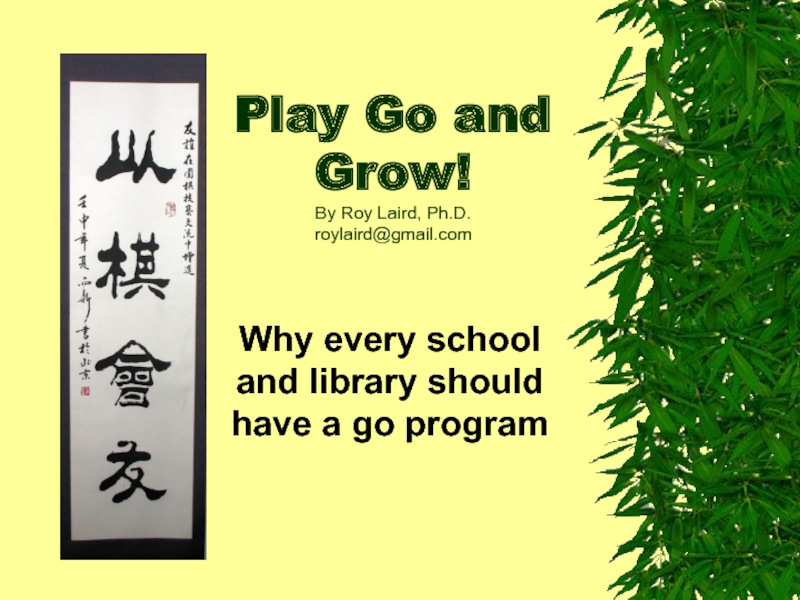

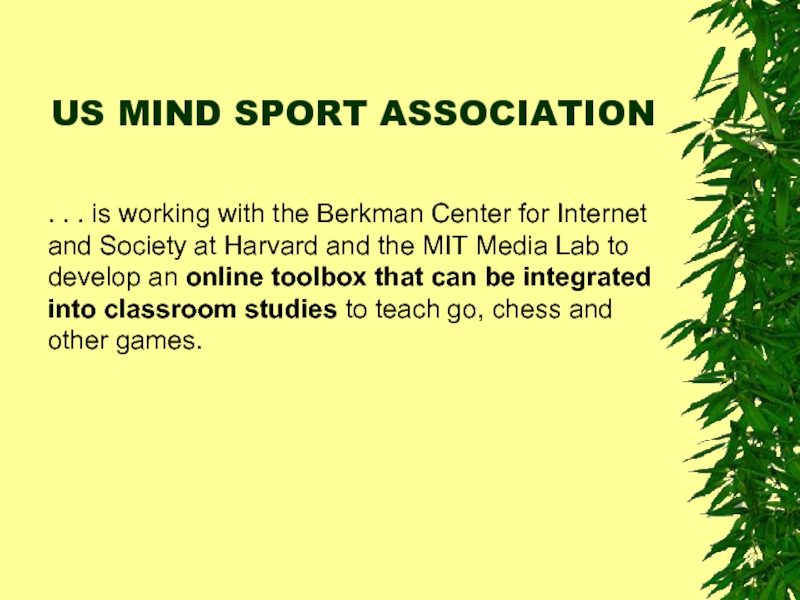
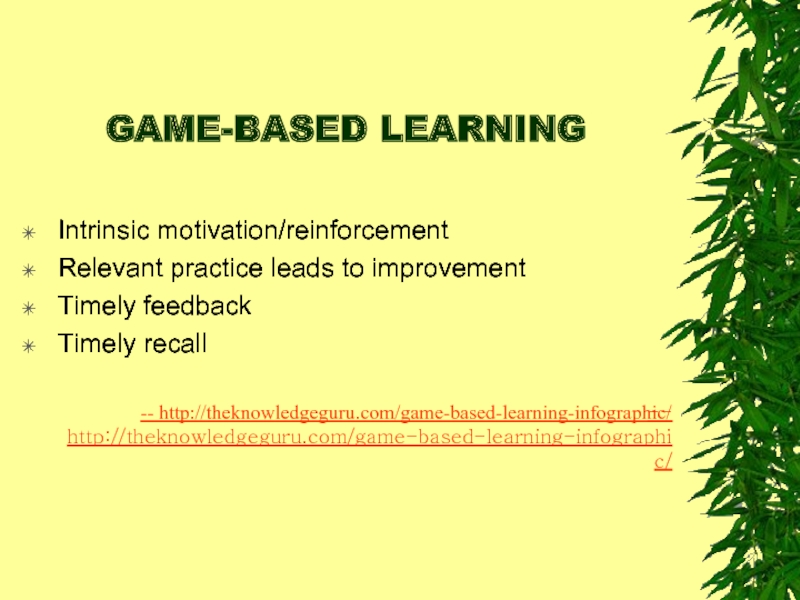
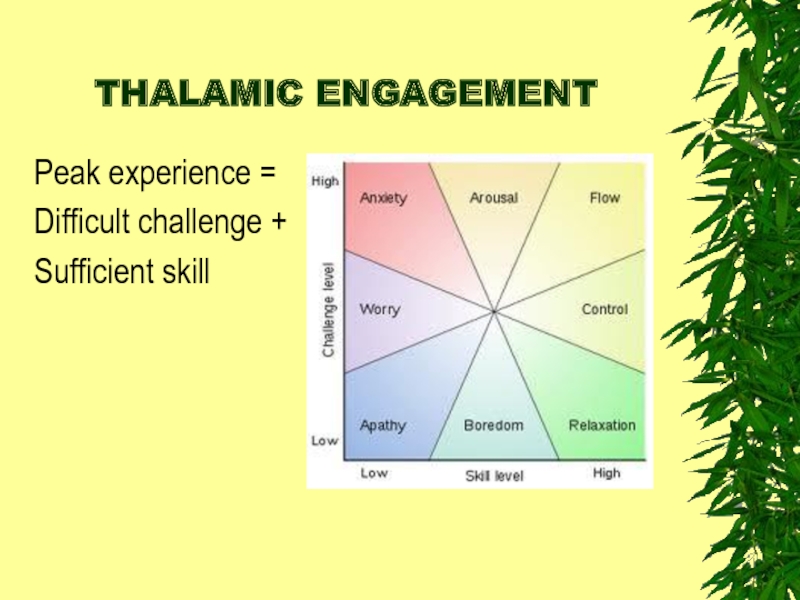
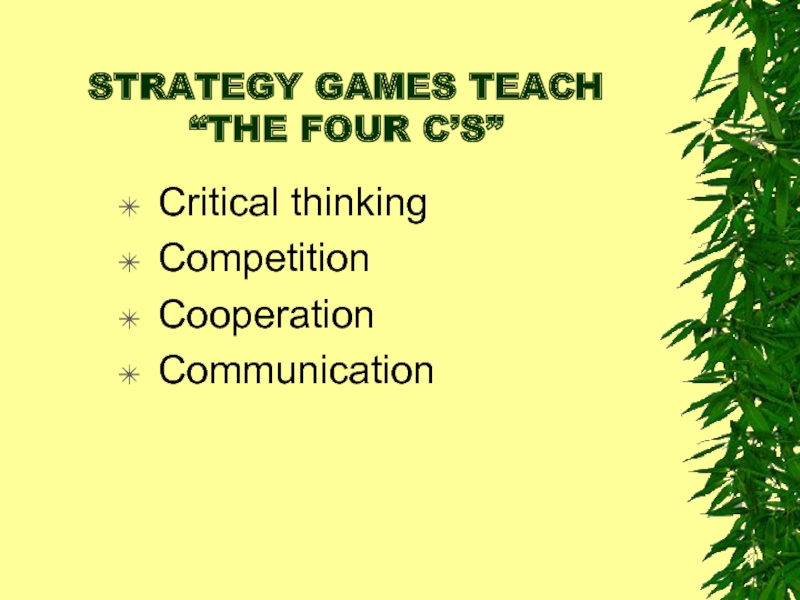
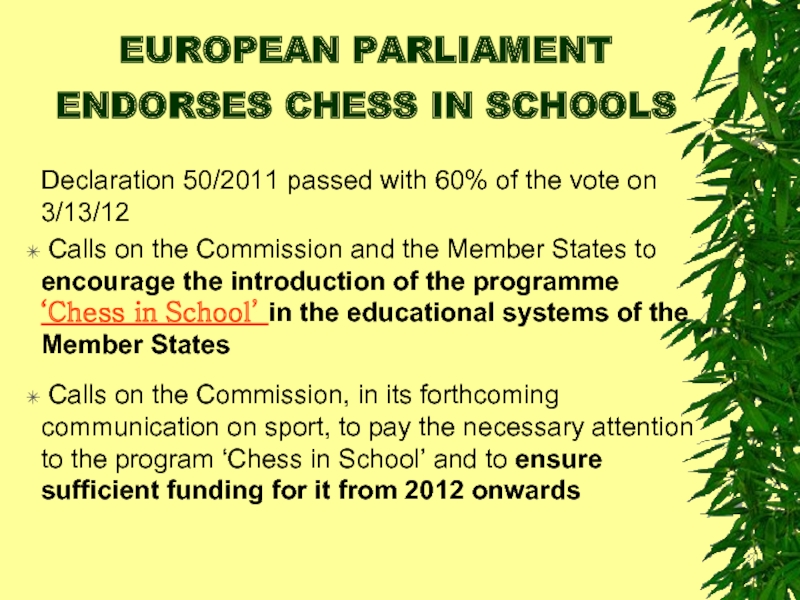
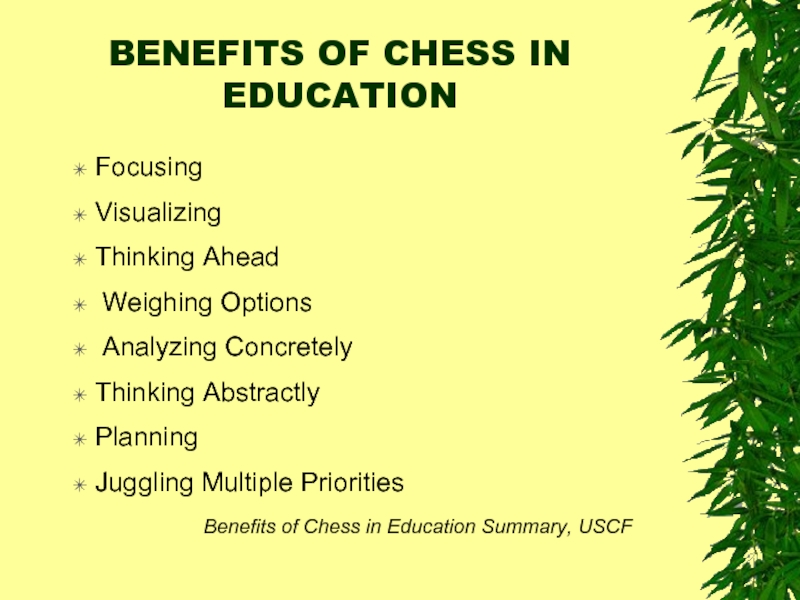

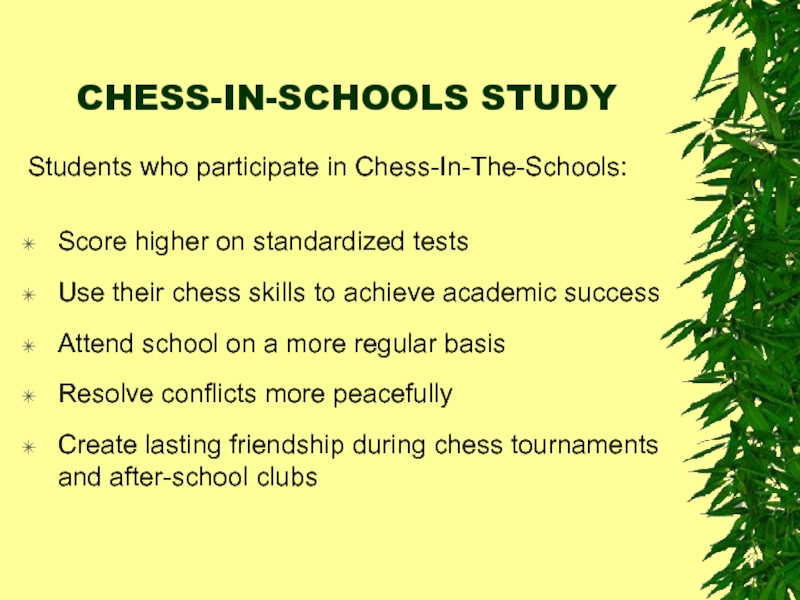
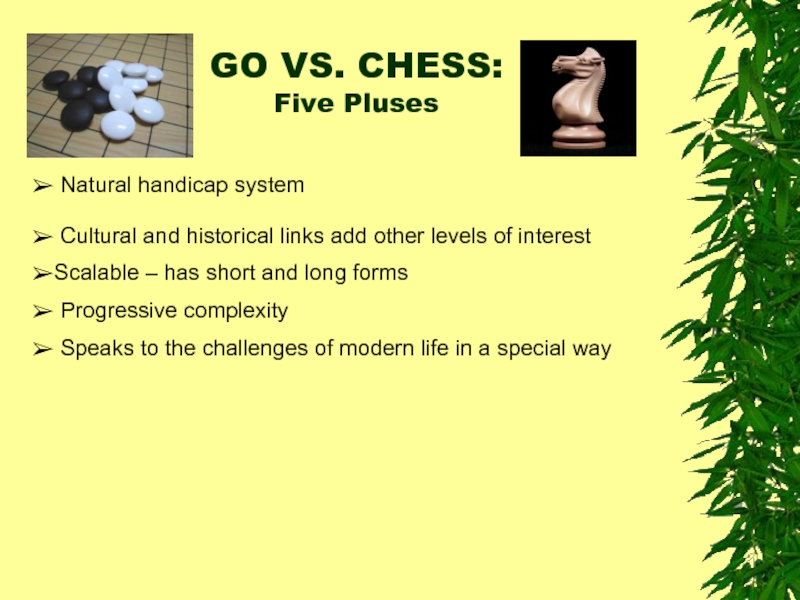

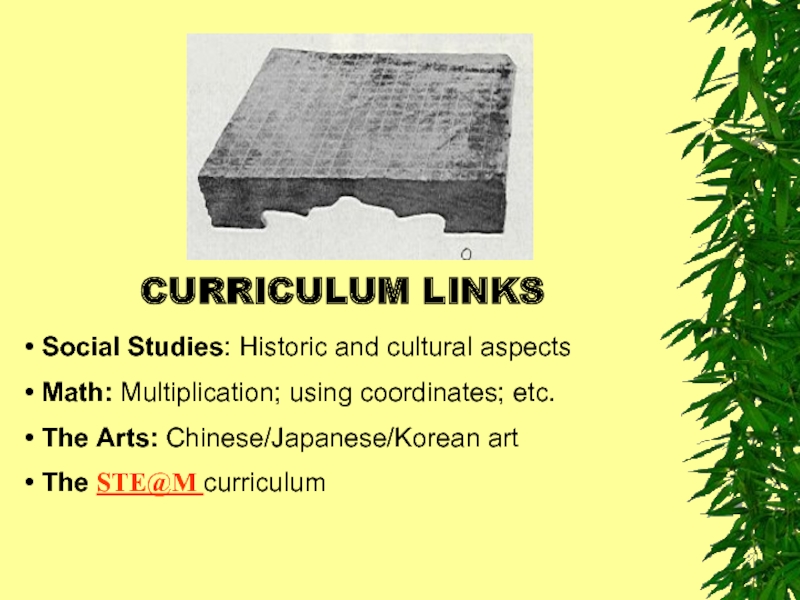
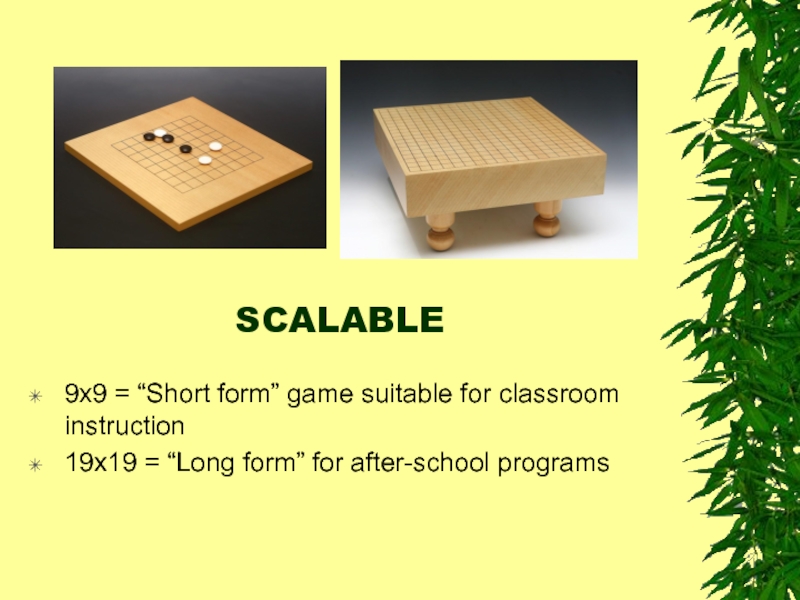
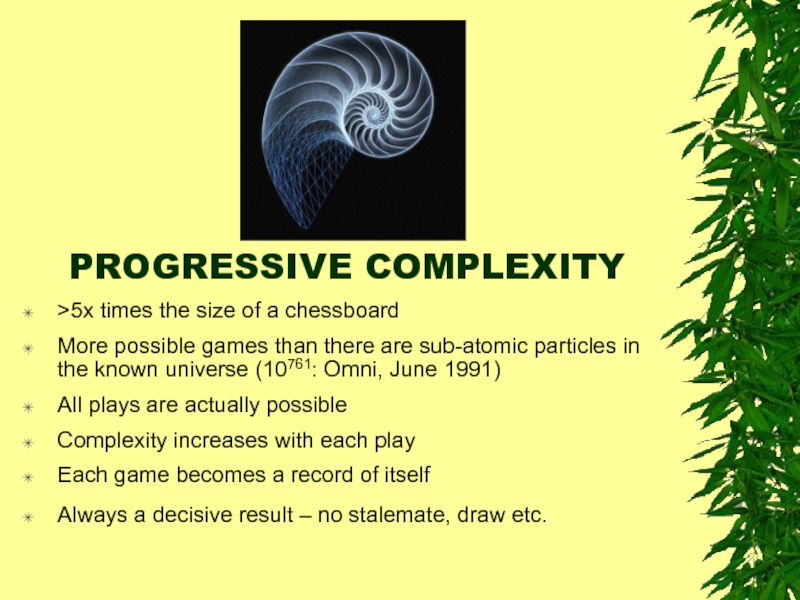
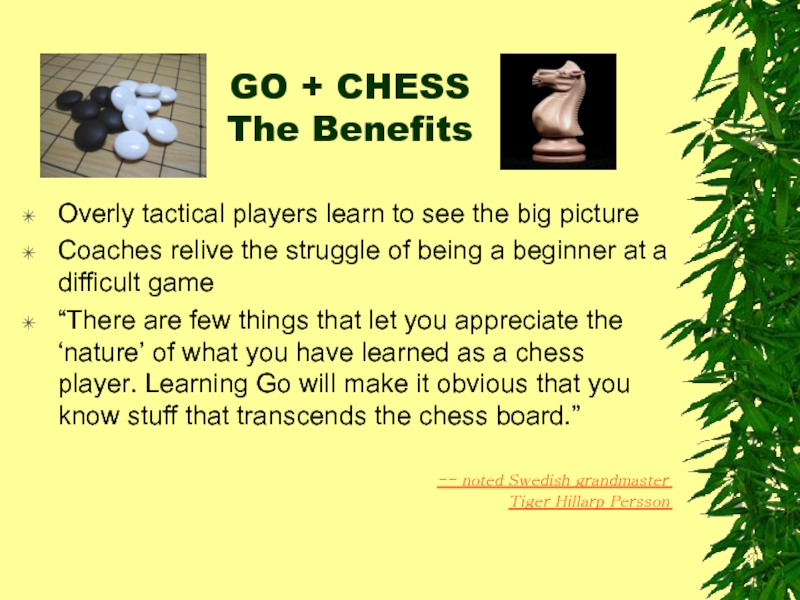
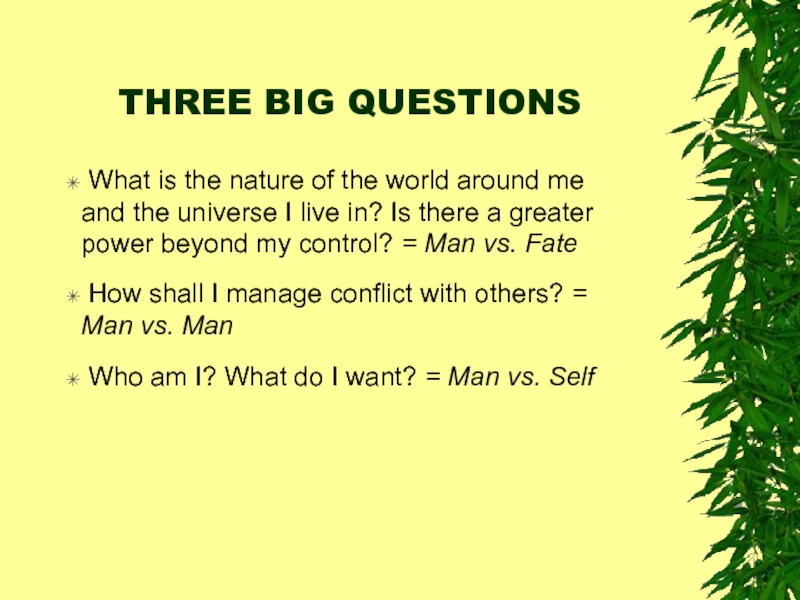
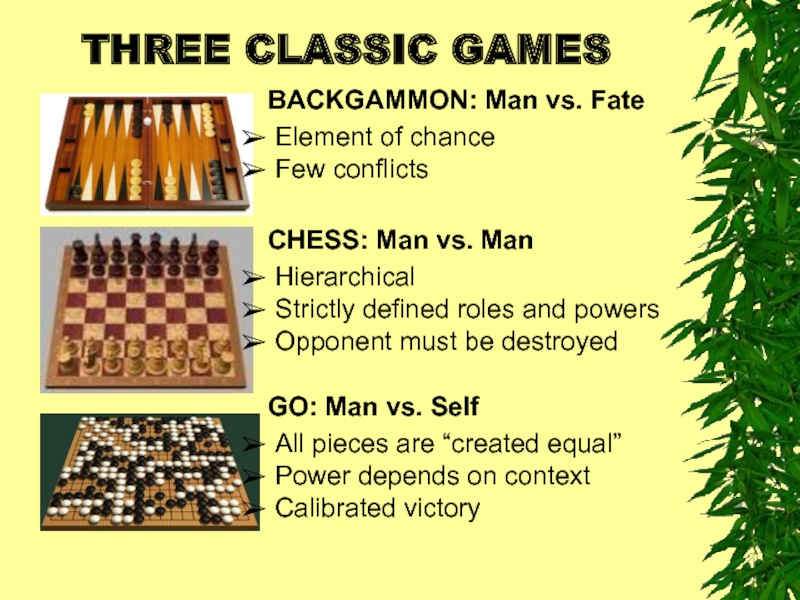
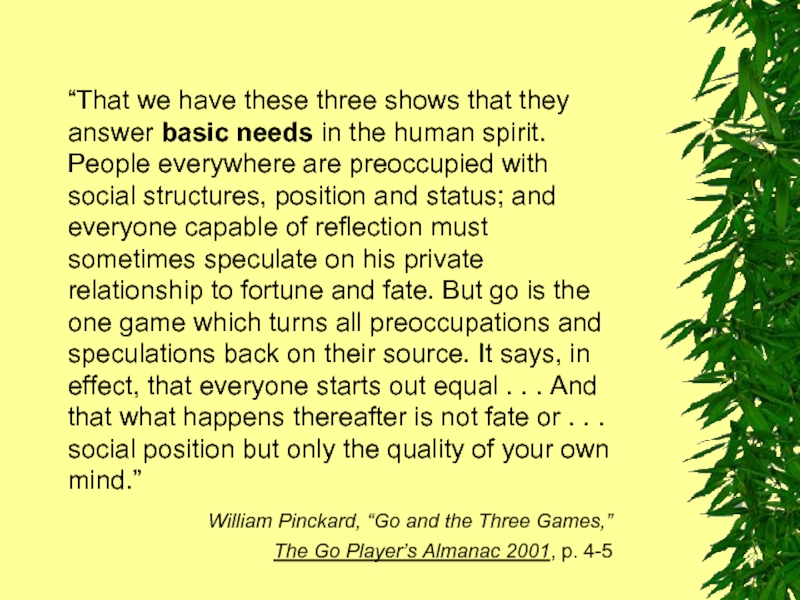
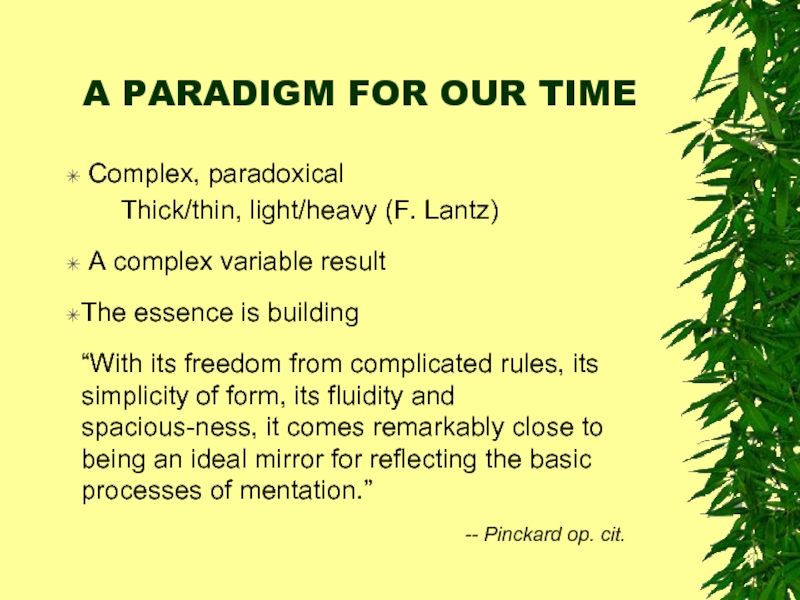


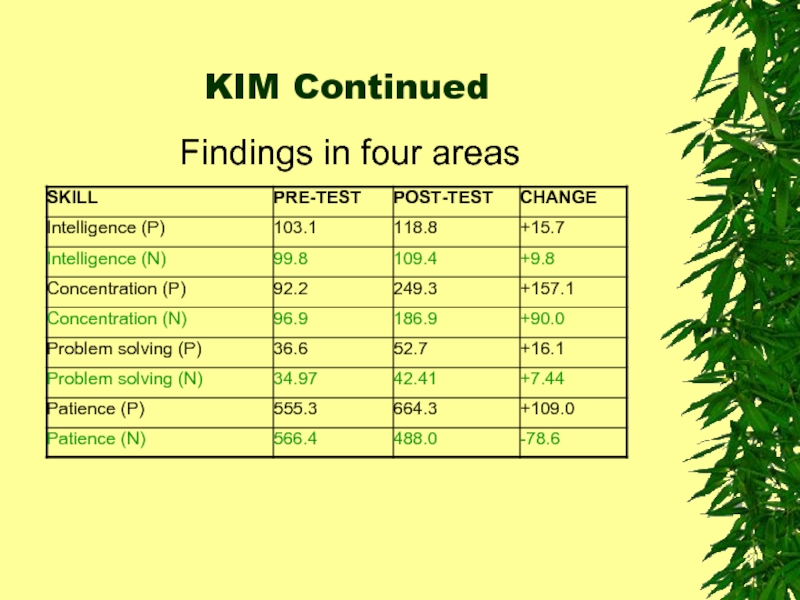
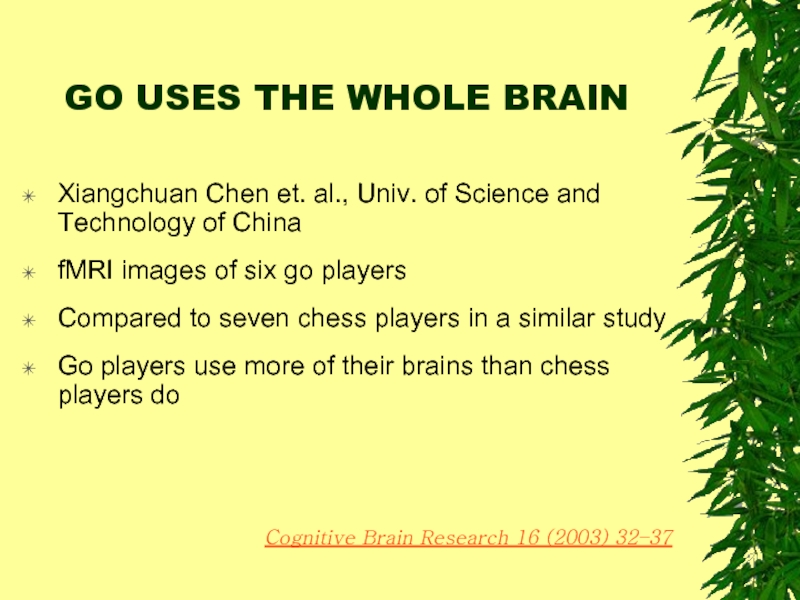
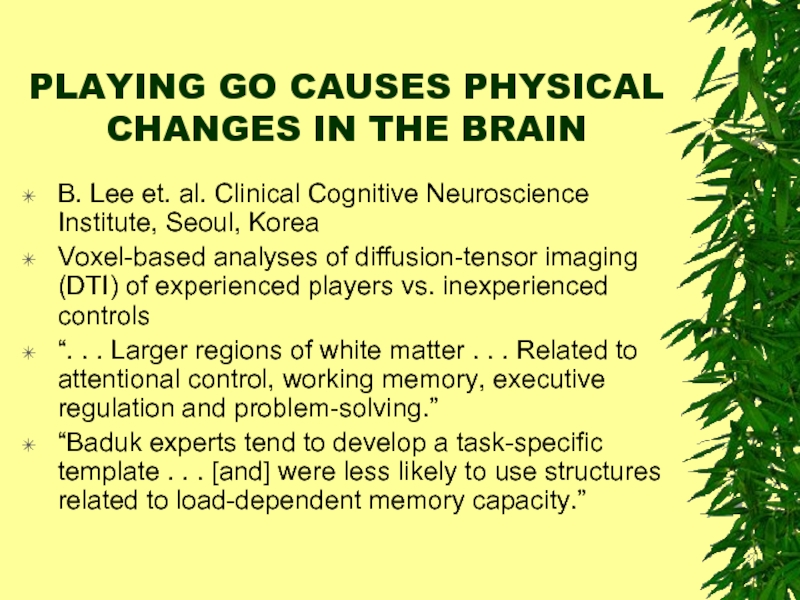
![PHYSICAL CHANGES CONTD.“Long-term baduk training appears to cause structural brain changes. . . . [Understanding]](/img/tmb/2/141597/788c1f581e4bf73dc3373abc6a0a9caa-800x.jpg)
